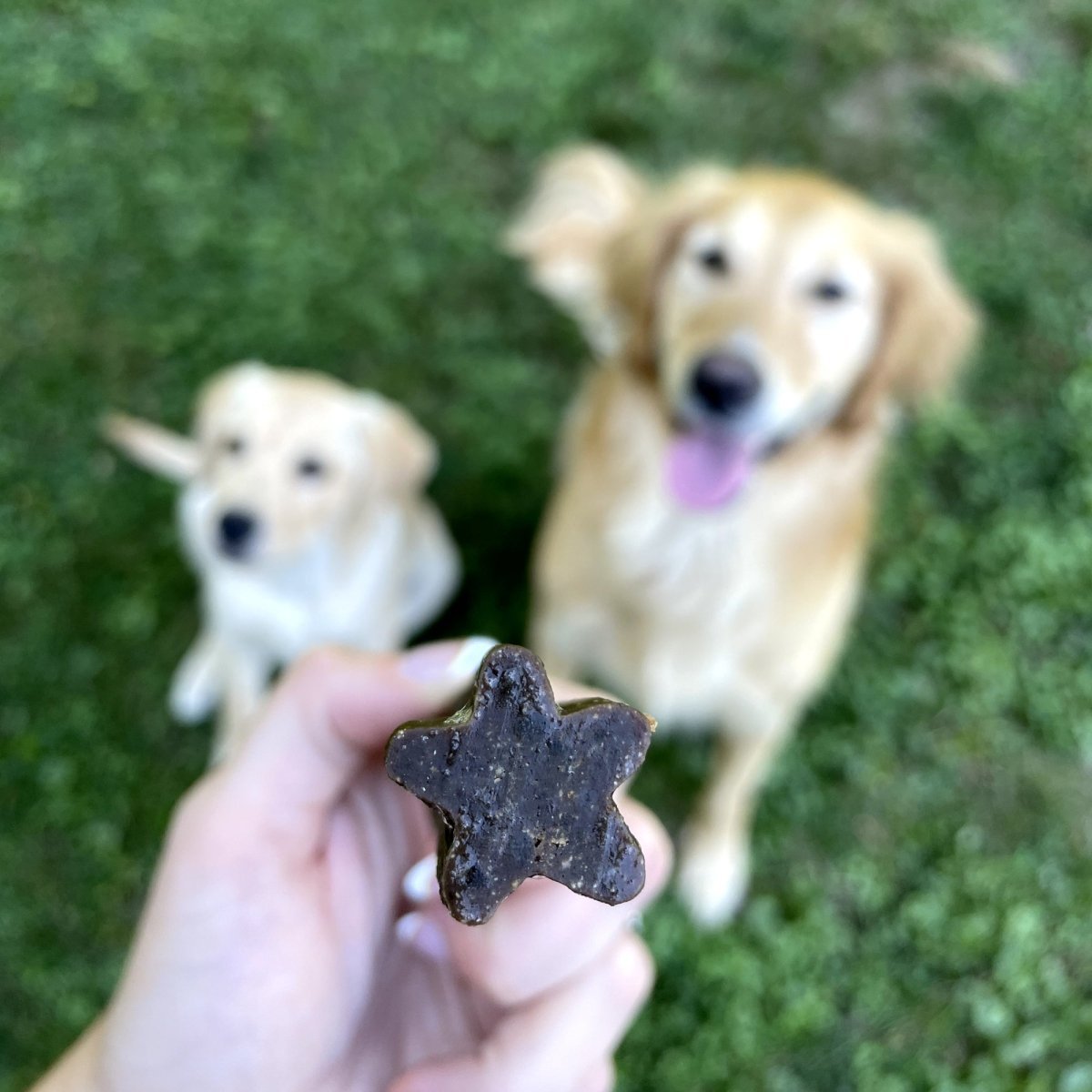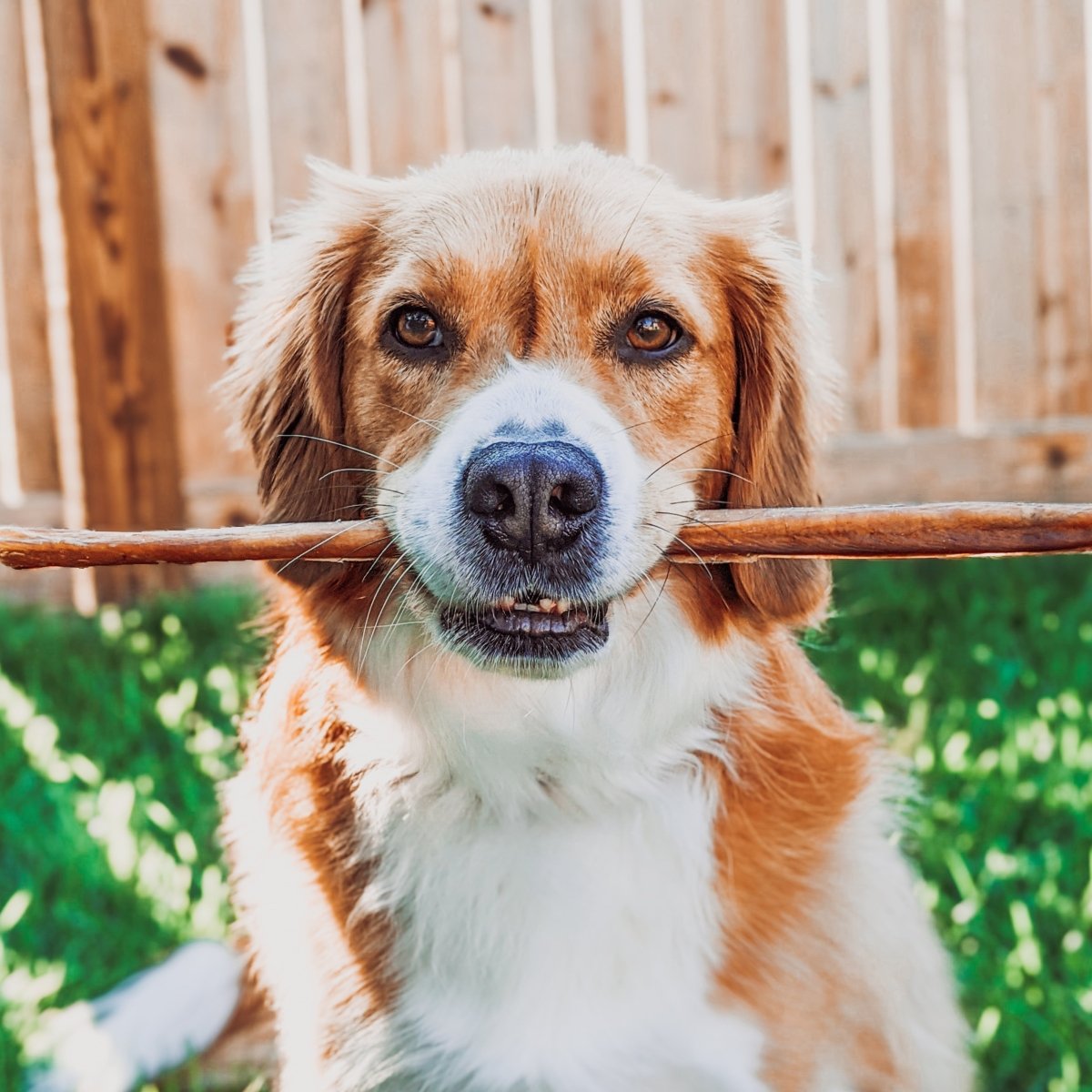

A loud thunderstorm can be enough to turn even the biggest, toughest guard dog into a quivering puddle of fur. If your dog is afraid of thunder and lightning, then the summer storm season can be tough for you all — but there are ways to help your pup cope with their fear of storms. In this ultimate guide, we briefly explain why dogs are afraid of storms and then dive into 12 practical tips for calming your dog during a storm, from distracting them with bully sticks to trying anti-anxiety medication:
Multiple aspects of storms cause anxiety for dogs, all of which are heightened due to the dog's increased sensitivity. For one, many dogs are noise averse — not just to thunder, but also other loud noises such as fireworks and gunfire. A noise that simply sounds loud to humans can be overpowering to a dog and send them cowering in fear.
The flashing lights from lightning can also be another contributing factor to a dog’s fear during thunderstorms. (This may also be another reason why your dog doesn't like fireworks.) The lightning essentially acts as a strobe light in the sky, which is bewildering and frightening to dogs who don’t understand what’s happening.
Lightning is also related to another cause of dog’s discomfort: static electricity. Lightning is caused when the ice crystals in cold clouds bump together with the water droplets in warm clouds. This friction produces electrical charges that result in lightning. It also increases the static electricity in the air, which can cling to your dog’s fur and make them extremely uncomfortable.
Dogs who are afraid of storms may participate in behaviors such as howling, excessive barking, destroying things, and urinating or defecating in the house. However, their anxiety behavior may also take more subtle forms, such as panting, drooling, trembling, shaking, lowered ears and tail, widened eyes, and clawing. Keep an eye on the forecast and also on your dog’s body language to see if they are afraid of storms, even if they don’t make a commotion about it.
If your dog gets anxious during thunderstorms, don’t despair, because there are plenty of practical steps that you can take to make the experience less stressful for both of you. Here are 12 things that you can do to calm your dog in a storm:

Dogs pick up on human emotions, so if you’re anxious and stressed — even if it’s not because of the storm — that can make your dog’s fear even worse. We know that it can be really stressful to see your dog shaky and scared, but try to keep your own emotions in check, lest you accidentally contribute to their fear. Keep your body language relaxed and open and your voice calm and upbeat (but not too high, which can excite your dog). Try not to mirror your dog’s anxiety back to them and instead focus on projecting serene, quiet energy.
If your dog is normally an outside dog, you should definitely bring them inside during storms! That’s because many dogs have been known to get spooked by thunder and lightning and run off during storms, and the adverse weather will make it more difficult to find any lost pets. Keep an eye on the forecast and bring your dog in well before any weather events are predicted to happen. Make sure to take them outside to use the bathroom in advance of the storm and keep them attached to a leash so that they can’t bolt if there are early rumblings of thunder.
Dogs are den animals, and having a small, cozy space to curl up inside is very calming for them. If your dog loves their crate, that can work well as a den, especially if you drape a blanket over it to muffle light and noise and give them something soft to lie on. Don’t shut the door of the crate, however. Your dog should be able to come and go as they please so they don’t feel trapped. If your dog is not a fan of their crate, it’s better to make them a bed in one of their favorite rooms, perhaps in a closet or under a desk so they can feel protected. If you allow them on the furniture, they might even like curling up in your bed under the covers.
Covering up the sounds of thunder can help calm your dog and make the loud noises less prominent. You can accomplish this by turning on the TV, playing music, or even just putting white noise on in the background. Choose a noise that will be soothing to both you and your dog, such as classical music or a documentary with quiet narration. Avoid music and media with loud, sudden noises that could trigger your dog’s anxiety further. Now is not the time to put on the pulse-pounding action movie with loud battle scenes.

If your dog is willing to engage, doing an activity with them can help distract them from the storm and help calm them down faster. This distraction can take many forms, from brushing their coat to throwing a ball with them to playing tug of war with a rope to giving them a long-lasting dog bone. You might need to try several activities to get their attention, so don’t be afraid to experiment to figure out what will distract them the best. If they’re too afraid to engage at all, then you can simply coexist together to let them know that they’re not alone.
Shop for Long-Lasting Dog BonesWhen trying to comfort or distract your dog during a storm, it’s really tempting to lavish attention and praise on them. However, this can sometimes backfire by teaching the dog that they can get your attention by howling, peeing on the floor, and other inappropriate behaviors that are associated with their fear of storms. If your dog engages in these behaviors, try to ignore them as much as possible. Instead, give them attention and praise when they quietly lie down or choose to play with a toy instead.
In addition to being upset by the loud blasts of thunder, dogs may also find the flashing bolts of lightning distressing as well. We recommend closing the blinds and drawing the curtains before a storm starts to block out these flashing lights and to help muffle the sound as well. Some dogs may want to bury their head in a blanket or towel, but let them take the lead on that. Some dogs get super agitated if their heads or eyes are covered against their will, so let them make the call on whether or not they want their face covered.

While the Thundershirt is probably the best-known form of anxiety-reducing apparel for dogs, there are many options on the market today, including wraps and capes in addition to vests. If your dog enjoys the feeling of pressure that comes from being held, they may benefit from wearing one of these during storms. Be sure to buy the correct size. If it’s too loose, it won’t provide any benefits, but if it’s too tight, then your dog will feel trapped and claustrophobic. Put it on your dog before the storm starts and they start to become anxious, since getting a panicking dog into a Thundershirt can be a difficult or impossible task.
If your dog constantly runs to the bathtub during storms, they might be bothered not by the noise, but rather by the static electricity in their fur (porcelain blocks electricity from traveling). You may have heard that you can wipe your dog down with dryer sheets, and it is okay to do this occasionally as long as you use an unscented sheet and don’t do it too often. But if your area gets storms pretty frequently, then you may want to invest in an anti-static cape that won’t leave any residue on your dog’s fur.
If none of these other options work, then it may be worth trying various dog anxiety remedies, including pheromones and calming CBD products. These products come in many forms, including pills, treats, sprays, and diffusers attached to collars. You can buy them over the counter and may also be able to pick them up at your local vet or pet store. Not all dogs respond to these products, but for some, it can make a really big difference in their storm anxiety in a positive way.
If storms are a frequent occurrence in your area, it may be worth trying to desensitize your dog through a thunderstorm conditioning program. While this may sound fancy, it’s really just a form of at-home exposure therapy that helps your dog get used to thunderstorm sounds. You do this by playing thunderstorm sounds at a low volume for 10 minutes or so while you are going about your normal routine. If your dog starts exhibiting fear behaviors, ignore them and redirect their attention to a toy or dog chew. Over the course of days or weeks, increase the volume of the sounds until your dog is no longer bothered by them. While this doesn’t work for other causes of storm anxiety, such as static electricity, it can be really helpful for dogs that suffer from noise aversion.

If your dog is still afraid of thunderstorms, don’t be afraid to pay a visit to your vet. There are lots of anti-anxiety medications available for dogs that can address a variety of conditions, including those triggered by storms. Your vet can assist you in devising a treatment plan to address your dog’s fear of storms from multiple angles. If you and your dog are still struggling during storms, don’t be afraid to reach out for an appointment.
You’ll want to have plenty of treats on hand for storm season, so consider getting a dog treat subscription from Best Bully Sticks so you never have to worry about running out. We offer a wide selection of high-quality, long-lasting treats to keep dogs occupied during storms, car rides, and more. Order more than $79 of product and get free shipping on your U.S. order!
Comments will be approved before showing up.

Dental chews keep plaque in check and gums strong. Read here to learn about nature's toothbrush!

Single-ingredient dog chews and treats are crafted using only one whole food source!

Check out our guide on different types of chews to help you decide on the best chew for your dog!